Chapter 22C.160
SIGNS
Sections:
22C.160.040 Application requirements and fee schedule.
22C.160.060 Construction standards.
22C.160.090 On-premises requirement.
22C.160.120 Subarea master plan and special overlay districts.
22C.160.140 Measurement standards.
22C.160.150 Residential zones.
22C.160.170 Freestanding signs.
22C.160.180 Electronic message, animated and changeable copy signs.
22C.160.190 Instructional signs.
22C.160.220 Marquee/awning signs.
22C.160.230 Under-canopy signs.
22C.160.240 Building identification wall sign.
22C.160.250 Gas stations, convenience stores, car washes and similar uses.
22C.160.270 Nonconforming signs.
22C.160.280 Amortization for billboard signs.
22C.160.290 Bonus allowance for outstanding design.
22C.160.010 Purpose.
The purpose of this chapter is to provide for the reasonable display of signs necessary for public service or the conduct of business. The regulations enacted herein are necessary to protect the safety and welfare of the public and to maintain an attractive appearance in the community. This chapter authorizes and regulates the use of signs visible from a public right-of-way and/or adjacent property to:
(1) Provide a reasonable balance between the right of an individual to identify a business and the right of the public to be protected against the unrestricted proliferation of signs; and
(2) Support the economic well-being of businesses by allowing businesses to identify their premises and advertise products and services; and
(3) Provide minimum standards to safeguard life, health, property and the general welfare by regulating and controlling the design, quality of materials, construction, location, electrification and maintenance of all signs and sign structures; and
(4) Ensure that signs are compatible with adjacent land uses; and
(5) Protect the public from hazardous conditions resulting from signs that are structurally unsafe, obscure vision of motorists, distract motorists, or interfere with traffic signs and signals; and
(6) Minimize overhead clutter for drivers and pedestrians; and
(7) Provide for types and sizes of signs appropriate to the land uses and zoning districts of the city; and
(8) Encourage well-designed signs that are compatible both with surrounding land uses and the buildings to which they are appurtenant; and
(9) Provide for the orderly and reasonable elimination of existing signs that are not in conformance with this chapter to protect the public health, safety, and welfare; and
(10) Provide a reasonable amortization period for businesses which have made a substantial investment in off-premises signs (billboards); and
(11) Implement the goals and policies of the Marysville comprehensive plan; and
(12) Protect property values by encouraging signs that are appropriate in both scale and design to surrounding buildings and landscape, and by discouraging a needless proliferation of the number of signs. (Ord. 3195 § 3 (Exh. A), 2021).
22C.160.020 Authority.
(1) Administration. The community development director will administer these sign standards as set forth in Chapter 22G.010 MMC, Land Use Application Procedures. The director may implement procedures, forms, and written policies for administering the provisions of this chapter.
(2) Enforcement. This chapter will be enforced by the code enforcement officer.
(3) Violations. Violations of this chapter are civil infractions enforced under MMC Title 4. (Ord. 3195 § 3 (Exh. A), 2021).
22C.160.030 Permits required.
It shall be unlawful to erect or display a sign in the city without a sign permit issued by the community development department, except for those exempted in MMC 22C.160.080. (Ord. 3195 § 3 (Exh. A), 2021).
22C.160.040 Application requirements and fee schedule.
(1) Applications for sign permits shall be made to the building official upon forms provided by the community development department. Such application shall require:
(a) Name, address, telephone number and email address of the applicant.
(b) Name, address, telephone number and email address of the sign owner.
(c) Tax parcel number or correct address where the proposed sign or signs will be located.
(d) A scaled drawing of the proposed sign or sign revision, including size, height, copy, structural footing details, method of attachment and illumination.
(e) A scaled site plan, indicating the location of the sign relative to property lines, rights-of-way, streets, sidewalks, and other buildings or structures on the premises.
(f) The number, size, type and location of all existing signs on the same building, lot or premises.
(2) Fee Schedule. Fees for sign permits are as provided by MMC 16.04.045, Table 1-A. (Ord. 3195 § 3 (Exh. A), 2021).
22C.160.050 Inspections.
(1) Inspections are required for all signs requiring a permit. The building division shall be contacted for inspections at the following points of the project:
(a) Prior to pouring footings for freestanding signs. The applicant will be required to provide enough field information for the inspector to determine that the proposed sign complies with applicable setback provisions.
(b) Foundation, anchorage, attachments and other structural support of the sign, sign structure and awning.
(c) Electrical connections of the sign, sign lighting or awning lighting. No person may make connections of a sign, sign lighting or awning lighting to a power source until all electrical components and connections have been approved.
(d) Final sign installation to determine compliance with the approved plans.
(2) Special inspections may be required for complex signs as specified by the licensed design professional or the building official. Notice will be given to the applicant as part of the permit review process when a special inspection is required. (Ord. 3195 § 3 (Exh. A), 2021).
22C.160.060 Construction standards.
The construction, erection, safety and maintenance of all signs shall comply with MMC Title 16 and the following:
(1) Signs shall be structurally sound and located so as to pose no reasonable threat to pedestrian or vehicular traffic.
(2) All permanent freestanding signs shall have self-supporting structures erected on, or permanently attached to, concrete foundations.
(3) Signs should not be in locations that obscure architectural features such as pilasters, arches, windows, cornices, etc.
(4) Signs should not be in locations that interfere with safe vehicular and pedestrian circulation or public safety signals and signs.
(5) No signs shall be erected, constructed or maintained so as to obstruct any fire escape, required exit, window, or door opening used as a means of egress. (Ord. 3195 § 3 (Exh. A), 2021).
22C.160.070 Prohibitions.
The following signs are prohibited in the city and are subject to the specific prohibitions, requirements, and exceptions set forth below for each type of sign:
(1) Billboards. Billboards shall be removed subject to the amortization schedule outlined in MMC 22C.160.280.
(2) Animated signs. No sign shall be animated, revolve or rotate either mechanically or by illumination, except for the movement of the hands of a clock, permitted electronic message signs, and barber poles.
(3) Roof signs.
(4) Internally illuminated cabinet or box signs. Sign face is illuminated through translucent casing. This prohibition includes internally illuminated changeable copy signs.
(5) Hazardous signs. A sign is hazardous if it creates a safety hazard for pedestrians or motorists, as determined by the police chief or city engineer.
(6) Signs located in or on public right-of-way. No signs shall be located upon or projecting over public streets, or sidewalks except as provided for projecting wall signs in MMC 22C.160.210. Temporary signs may be located in the right-of-way when they conform to the requirements of MMC 22C.160.260.
(7) Temporary signs. Temporary signs not meeting the requirements of MMC 22C.160.260 are prohibited. This prohibition includes, but is not limited to, portable readerboards, signs on vehicles or trailers, banners and sandwich or A-boards; provided, that sandwich or A-board signs may in certain circumstances be specifically allowed as set forth in this chapter. Temporary signs must conform to the requirements of this section unless specifically exempted.
(8) Signs on utility poles and trees. Signs on utility, street light and traffic control standards or poles and trees are prohibited, except for those of the utility or government.
(9) Signs not meeting the requirements of this chapter or that are legally nonconforming. The following signs are unlawful and prohibited:
(a) Signs which were lawful under prior sign codes, but which are not lawful under this chapter.
(b) Signs that do not comply with the conditions of their permits.
(c) Signs erected, altered or relocated without a permit and not in compliance with this chapter.
(d) Signs which were lawful under prior sign codes, but which have been altered or relocated so that the sign is not in compliance with this chapter.
(e) Signs that identify and advertise activities, products, businesses, or services which have been discontinued, terminated or closed for more than 60 days on the premises upon which the signs are located.
(10) Streamers, pennants, and banners. Displays of banners, festoons, flags, posters, pennants, ribbons, streamers, strings of lights, chasing strobe or scintillating lights, flares, balloons, bubble machines and similar devices are prohibited when the same are visible from any off-site location, including but not limited to any public right-of-way, except on a limited basis as provided in MMC 22C.160.260(1)(k). Where such signs or devices are not visible from off site, this prohibition does not apply.
(11) Traffic-like signs. Signs which by reason of their size, location, movement, content, coloring or manner of illumination may be confused with a traffic control sign, signal, or device, or the light of an emergency vehicle, or which obstruct the visibility of any traffic or street sign or signal, are prohibited.
(12) Obscene signs. Signs which bear or contain statements, words or pictures which are obscene under the prevailing statutes or applicable state and federal court decisions are prohibited. (Ord. 3296 § 3 (Exh. C), 2023; Ord. 3195 § 3 (Exh. A), 2021).
22C.160.080 Exemptions.
The following signs are exempted from obtaining a sign permit, but must comply with all other requirements of this chapter and with the specific requirements set forth below for each type of sign:
(1) A change in the face of the sign or advertising copy of an existing, legally permitted sign.
(2) Temporary signs meeting the requirements of MMC 22C.160.260.
(3) Nonelectric signs not exceeding eight square feet per face, which are limited in content to the name of occupant and address of the premises in a residential zone.
(4) Instructional signs located on private property, not exceeding eight square feet per sign; provided, that foundation, anchorage, attachments and other structural support of the sign and electrical connection require construction permits.
(5) Menu signs located on private property. Foundation, anchorage, attachments and other structural support of the sign and electrical connection require construction permits.
(6) Sculptures, fountains, benches, lighting, seasonal decorations, mosaics, murals, landscaping and other street furniture and design features, which do not incorporate advertising or identification.
(7) Signs not visible from public way. Exterior and interior signs or displays not intended to be visible from streets or public ways, signs in the interior of a building more than three feet from the closest window and not facing a window, window displays and point of purchase advertising displays such as vending machines.
(8) Traffic or other municipal signs, signs required by law or emergency services, railroad crossing signs, legal notices, and any temporary signs specifically authorized by the city council or authorized under policies and procedures adopted by the city council.
(9) Signs of public utility companies indicating danger or which serve as an aid to public safety or which show the location of underground facilities or of public telephones.
(10) Memorial signs or tablets, names of buildings, stained glass windows and dates of erection when cut into the surface of the facade of the building or when projecting not more than two inches.
(11) Incidental signs, including, but not limited to, “no trespassing,” “no dumping,” “no parking,” “private,” signs identifying essential public needs (i.e., restrooms, entrance, exit, telephone, etc.) and other information warning signs, which shall not exceed three square feet in surface area.
(12) Flush-mounted wall signs which are used to identify the name and address of the occupant for each dwelling, provided the sign does not exceed two square feet in sign area.
(13) Gateway entrance signs. Gateway entrance signs that comply with the city of Marysville gateway master plan. Foundation, anchorage, attachments and other structure support of the sign and electrical connection require building permits.
(14) Public way finding, directional, and interpretive signs. Foundation, anchorage, and other structure support of the sign and electrical connection require building permits. (Ord. 3296 § 4 (Exh. D), 2023; Ord. 3195 § 3 (Exh. A), 2021).
22C.160.090 On-premises requirement.
All signs shall be located on premises; provided, that temporary off-premises signs shall be allowed subject to the provisions set forth in MMC 22C.160.260. In addition, property owners may apply for an off-premises freestanding sign with a contiguous property abutting a public street, subject to the following criteria:
(1) The allowable off-premises freestanding sign area shall be determined by measuring the street frontage of the property abutting the public street, as provided in MMC 22C.160.140(5).
(2) Off-premises freestanding signage shall comply with all applicable development standards set forth in this chapter.
(3) Applicants may apply for a bonus allowance, subject to the criteria set forth in MMC 22C.160.290. (Ord. 3195 § 3 (Exh. A), 2021).
22C.160.100 Maintenance.
Signs shall be maintained in the same condition as when the sign was installed. Normal wear and tear of aged signs shall be repaired when they detract from the visible quality of the sign, as determined by the community development director. When signs are repaired, they must do so in a manner (paint colors shall match, etc.) that is consistent with the approved sign permit. When signs are removed, the wall behind the sign shall be repaired and painted to match the rest of the building wall. The premises surrounding a freestanding sign shall be free of litter, and any landscaped area shall be maintained.
Those signs found to be deteriorated or unsafe shall be repaired or removed by the owner within 10 days after receiving notice from the community development director or designee. (Ord. 3195 § 3 (Exh. A), 2021).
22C.160.110 Abandoned signs.
Abandoned signs shall be removed by the property owner or lessee within 60 days after the business or service advertised by the sign is no longer conducted on the premises. If the property owner or lessee fails to remove it, the community development director, or designee, shall give the owner 10 days’ written notice to remove it. Upon failure to comply with this notice, the city of Marysville may remove the sign at the cost of the owner of the premises. The foundations and posts of a sign, with all advertising copy removed, may remain on the premises for up to three years with the owner’s written consent, on the condition that the same must be continuously maintained pursuant to MMC 22C.160.100. (Ord. 3195 § 3 (Exh. A), 2021).
22C.160.120 Subarea master plan and special overlay districts.
In general, all signs are subject to sign regulations outlined in this chapter. When the regulations of a subarea master plan or special overlay district conflict with this chapter, unless specifically indicated otherwise, the regulations of the subarea master plan or special overlay district supersede the regulations of this chapter. (Ord. 3195 § 3 (Exh. A), 2021).
22C.160.130 Illumination.
The following standards apply to all illuminated signs:
(1) Sign illumination shall not interfere with the use and enjoyment of adjacent properties, create a public nuisance, or create public safety hazards. Exterior light sources shall be shielded from view and directed to illuminate only the sign face.
(2) No sign shall have blinking, flashing, moving or fluttering lights or other illuminating devices that have a changing light intensity, brightness or color.
(3) Illuminated signs shall not create a hazardous glare for pedestrians or vehicles either in a public street or on any private premises and shall not project towards the sky.
(4) The light from an illuminated sign shall not be of an intensity or brightness or directed in a manner that will create a negative impact on residential properties in direct line of sight to the sign.
(5) Colored light shall not be used at a location or in a manner so as to be confused or construed as a traffic control device.
(6) Reflective-type bulbs and incandescent lamps that exceed 15 watts shall not be used on the exterior surface of signs so that the face of the bulb or lamp is exposed to a public right-of-way or adjacent property.
(7) Light sources shall utilize energy efficient fixtures to the greatest extent possible.
(8) Each illuminated sign shall be subject to a 30-day review period, during which time the community development director or designee may determine that a reduction in illumination is necessary due to negative impacts on surrounding property or the community in general. In addition, and at any time, the community development director or designee may order the dimming of any illumination found to be excessively bright. The community development director’s determination will be made without regard to the message content of the sign. (Ord. 3195 § 3 (Exh. A), 2021).
22C.160.140 Measurement standards.
(1) Determining Sign Area and Dimensions.
(a) For a wall sign which is framed, outlined, painted or otherwise prepared and intended solely to provide a background for a sign display, the area and dimensions shall include the entire portion within such background or frame.
(b) For a wall sign comprised of individual letters, figures or elements on a wall or similar surface of the building or structure, the area and dimensions of the sign shall encompass a regular geometric shape (rectangle, circle, trapezoid, triangle, etc.), or a combination of regular geometric shapes, which form, or approximate, the perimeter of all elements in the display, the frame, and any applied background that is not a part of the architecture of the building. When separate elements are organized to form a single sign, but are separated by open space, the sign area and dimensions shall be calculated by determining the geometric form, or combination of forms, which comprises all of the display areas, including the space between different elements. Minor appendages to a particular regular shape, as determined by the community development director, shall not be included in the total area of a sign.
Figure 1: Wall Sign Area – Examples of Area Calculations

Measuring the examples using multiple geometric shapes
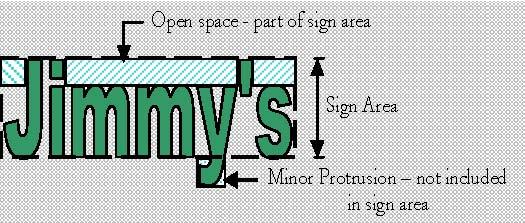
This illustrates the areas to be included within
the calculation of a sign area.
(c) For a freestanding sign, the sign area shall include the frame, if any, but shall not include:
(i) A pole or other structural support unless such pole or structural support is internally illuminated or otherwise designed so as to constitute a display device, or a part of a display device.
(ii) Architectural features that are either part of the building or part of a freestanding structure, and not an integral part of the sign, such as landscaping and building or structural forms complementing the site in general.
Figure 2: Freestanding Sign Area – Examples of Area Calculations
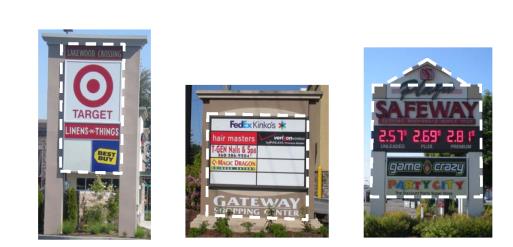
The dashed line indicates the sign area
(d) When two identical sign faces are placed back-to-back so that both faces cannot be viewed from any point at the same time and are part of the same sign structure, the sign area shall be computed as the measurement of one of the two faces.
(2) Determining Sign Height.
(a) The height of a freestanding sign shall be measured from the base of the sign or supportive structure at its point of attachment to the ground to the highest point of the sign. A freestanding sign on a manmade base, including a graded earth mound, shall be measured from the grade of the nearest pavement or top of any pavement curb.
(b) Clearance for freestanding and projecting signs shall be measured as the smallest vertical distance between finished grade and the lowest point of the sign, including any framework or other embellishments.
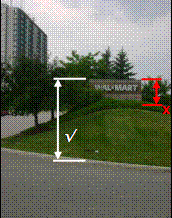
The height of a sign is measured from the grade of the street level where the sign is viewed; not from the top of the mound
(3) Determining Building Frontages and Frontage Lengths.
(a) Building Unit. The building unit is equivalent to the tenant space. The primary frontage of the tenant space on the first floor shall be the basis for determining the permissible sign area for wall signs.
(b) Primary and Secondary Frontage.
(i) Primary Frontage. Primary frontage shall be considered the portion of any frontage containing the primary public entrance(s) to the building or building units.
(ii) Secondary Frontage. Secondary frontage shall include those frontages containing secondary public entrances to the building or building units and all building walls facing a public street, primary parking area, or drive aisle that are not designated as the primary building frontage by subsection (3)(b)(i) of this section.
(4) Building Frontage.
(a) The primary or secondary frontage shall be all walls parallel, or nearly parallel, to such frontage, excluding any such wall determined by the community development director to be clearly unrelated to the frontage criteria.
(b) The frontage for a building unit shall be measured from the centerline of the party walls defining the building unit.
(5) Determining Street Frontage.
(a) Street frontage shall be determined by measuring the lineal feet of property abutting the public street from which a property obtains primary access.
(b) For developments located along more than one public street, the street frontage shall be determined by measuring the lineal feet of property abutting all public streets.
(c) Alley frontage shall not be included in determining street frontage.
(d) Properties abutting Interstate 5, and not abutting a public street, shall have the street frontage determined by measuring the lineal feet of property abutting Interstate 5. (Ord. 3195 § 3 (Exh. A), 2021).
22C.160.150 Residential zones.
In addition to all other provisions of this chapter, the following development standards apply in residential zones and on residentially developed properties, including residentially zoned and residentially developed properties within the downtown master plan area:
(1) The total combined area of all nonexempt signs, except temporary signs, on any lot in a residential zone shall not exceed nine square feet, except as provided in subsections (7) through (10) of this section.
(2) All dwelling units in residential districts shall display house numbers readable from the street.
(3) Illumination from or upon signs shall be shaded, shielded, directed or reduced so that the light intensity or brightness does not affect the enjoyment of residential property in the vicinity in any substantial way.
(4) Freestanding pole, or pylon, signs are prohibited.
(5) Roof signs are prohibited.
(6) No portion of a sign shall be in, or project over, a public right-of-way, and the minimum setback shall be five feet from all property lines unless attached to a fence. Signs shall not create a sight distance obstruction or any other safety hazard, and if attached to a fence shall not extend higher than the fence.
(7) Each entrance to a subdivision or multifamily development may have a monument sign up to 32 square feet in area, per face, or two single-faced signs of not more than 16 square feet each. These signs shall be located outside the public right-of-way so as not to create a visual obstruction for motorists or pedestrians. The height of such signs shall not exceed six feet.
(8) Existing recreation/cultural land uses (i.e., park, community center, library, church, etc.) and education services (i.e., public and private schools), not reviewed through the conditional use provisions outlined in subsection (10) of this section, may have one monument sign per street frontage up to 32 square feet in area, per face. The height of such signs shall not exceed six feet and shall comply with the development standards outlined in MMC 22C.160.170. In addition, a maximum of 32 square feet of permanent wall signage shall be allowed on the primary and secondary building frontage(s). Wall signs shall comply with the development standards outlined in MMC 22C.160.160.
(9) Home occupation, day care and adult family home signs shall not exceed three square feet and shall be wall signs, monument signs or mounted to a fence. Signs mounted to a fence shall comply with the provisions outlined in subsection (6) of this section.
(10) Signs for conditional uses permitted in residential zones shall be approved as part of the applicable conditional use permit and shall not be otherwise restricted by the provisions of this section.
(11) Temporary signs are permitted in compliance with MMC 22C.160.260. (Ord. 3296 § 5 (Exh. E), 2023; Ord. 3195 § 3 (Exh. A), 2021).
22C.160.160 Wall signs.
(1) The basic allowance for wall signs shall be limited to one and one-half square feet of sign area for each lineal foot of primary building frontage for illuminated signs, or two square feet of sign area for each lineal foot of primary building frontage for nonilluminated signs.
(2) Each tenant is allowed a minimum sign area of 32 square feet.
(3) Each tenant may have multiple wall signs placed on the primary or secondary building frontage(s), so long as the total wall signage does not exceed the allowances outlined in subsection (1) of this section.
(4) The community development director may allow wall signage to be placed on wall(s) which do not qualify as primary or secondary frontages, subject to the following criteria:
(a) It must be demonstrated that the wall signage would be visible from a public right-of-way;
(b) The wall signage must be comprised of individual letters;
(c) The letter and logo height shall not exceed 24 inches;
(d) Signs shall be nonilluminated;
(e) The wall signage shall comply with the design standards outlined in subsections (5) through (8) of this section;
(f) In multiuse complexes, said signs shall be mounted so that each tenant’s wall sign will be located at the same level (height above grade) as other tenants’ signs;
(g) The total wall signage for all frontage(s) shall not exceed the allowances outlined in subsection (1) of this section.
(5) The wall signage shall not exceed two-thirds of the overall frontage for the building or tenant(s) frontage, as applicable.
(6) The wall signage shall not encroach within three feet from the edge of the building or tenant(s) frontage, as applicable.
(7) Wall signs shall not extend above the building parapet, soffit, eave line, or roof of the building.
(8) The color, shape, material, lettering and other architectural details shall be harmonious with the character of the primary structure. No angle irons, guy wires, or braces shall be visible except those that are an integral part of the overall design. (Ord. 3195 § 3 (Exh. A), 2021).
22C.160.170 Freestanding signs.
(1) The basic allowance for freestanding signs shall be limited to one square foot of sign area for each lineal foot of street frontage not to exceed 200 square feet of sign area per street frontage and 75 square feet per sign face.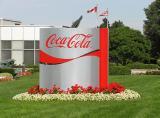
(2) The maximum height of freestanding signs is outlined in Table 1; provided, that monument signs shall not exceed 12 feet in height. Additionally, when the regulations of a subarea, master plan or special overlay district conflict, unless specifically indicated otherwise, the regulations of the subarea, master plan or special overlay district shall supersede the height requirements outlined in Table 1.
|
Zoning District |
||||||||||||
|---|---|---|---|---|---|---|---|---|---|---|---|---|
|
NB |
CB |
CB-WR |
GC |
DC |
DTC |
MS |
FLEX |
MU |
LI |
GI |
REC |
P/I |
|
4 feet |
25 feet |
12 feet |
25 feet |
6 feet |
12 feet |
6 feet |
6 feet |
12 feet |
25 feet |
25 feet |
4 feet |
15 feet |
(3) No portion of a freestanding sign shall be in, or project over, a public right-of-way, and the minimum setback shall be five feet, subject to sight distance review at intersections and driveways.
(4) Single-occupancy complexes are allowed one freestanding sign per street frontage.
(5) Multi-occupancy complexes are allowed one freestanding sign per access driveway for the complex. However, multi-occupancy complexes with only one access driveway shall be allowed one additional freestanding sign, as long as the freestanding sign advertises a different business or businesses located on site and can be spaced at least 150 feet apart.
(6) All pole, or pylon, sign supports shall be enclosed or concealed in accordance with the design criteria outlined in subsection (11) of this section.
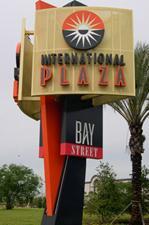
(7) Pole, or pylon, signs are prohibited in the NB, CB-WR, DC, DTC, MS, Flex, MU and REC zones.
(8) Pole, or pylon, signs are prohibited in the commercial and industrial zones located along the 51st Avenue NE, Grove Street, 88th Street NE (including CB-zoned properties located north and south of 88th Street NE on 36th Avenue NE), 116th Street NE, 152nd Street NE, 156th Street NE, and 160th Street NE corridors, and for properties located north of 152nd Street NE and east of Smokey Point Boulevard; provided, that properties that have direct frontage on Smokey Point Boulevard may have pole, or pylon, signs on their Smokey Point Boulevard frontage.
(9) Pole, or pylon, signs are prohibited on CB-zoned properties located adjacent to 64th Street NE (SR 528) and 84th Street NE from approximately 83rd Avenue NE to SR 9.
(10) Pole, or pylon, signs are prohibited within the boundary of the downtown master plan.
(11) Design and Materials.
(a) The base of a freestanding sign and all pole or pylon sign supports shall be constructed of durable high-quality materials such as stone, brick, textured concrete, decorative steel, or other quality materials and a design that relates to and/or complements the design of on-site buildings and/or is coordinated with other site design elements. This limitation does not apply to structural elements that are an integral part of the overall design such as decorative metal or wood.
(b) Freestanding signs must integrate a top, middle, and bottom element. The top could include a distinctive sign cap and/or include the name of a multitenant center. The middle can include a consistent framing technique for an individual sign or multiple signs in a multitenant center. The bottom could include a distinctive base design with special materials and/or design.
(c) The architecture and composition of a freestanding sign structure must provide visual interest and detail for both pedestrians and motorists at both automotive and pedestrian-scale speed and perception.
(d) The color, shape, material, lettering and other architectural details of freestanding signs shall be harmonious with the character of the primary structure.
(e) No angle irons, guy wires or braces shall be visible except those that are an integral part of the overall design.
(f) One square foot of landscaping is required per one square foot of sign face. Landscaping shall include a decorative combination of ground cover and shrubs to provide seasonal interest in the area surrounding the sign. Landscaping shall be well maintained at all times of the year. The director may reduce the landscaping requirement where the signage incorporates stone, brick, or other decorative materials.
(g) Departures from this subsection (11) will be considered by the director, provided the design complies with other standards herein and integrates a distinctive, high-quality design that contributes to the visual character of the area. (Ord. 3296 § 6 (Exh. F), 2023; Ord. 3244 § 6 (Exh. F), 2022; Ord. 3195 § 3 (Exh. A), 2021).
22C.160.180 Electronic message, animated and changeable copy signs.
(1) Changeable copy by nonelectronic means may be utilized on any permitted nontemporary sign.
(2) Animated signs are prohibited.
(3) One electronic message or changeable copy sign is permitted per street frontage for single-occupancy complexes. Multi-occupancy complexes with only one access driveway shall be allowed one additional electronic message or changeable copy sign, as long as the signs are spaced at least 150 feet apart.
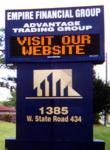
(4) Electronic message signs are permitted; provided, that the copy does not change more than once every 20 seconds.
(5) Electronic message and changeable copy signs shall not exceed 30 percent of the sign area.
(6) All electronic message and changeable copy signs shall be constructed as an integral part of a permanent sign constructed on site. “Integral” shall be considered to mean that the electronic message or changeable copy is incorporated into the framework and architectural design of the permanent sign.
(7) All electronic message signs are required to have automatic dimming capability that adjusts the brightness to the ambient light at all times of the day and night. (Ord. 3195 § 3 (Exh. A), 2021).
22C.160.190 Instructional signs.
(1) Instructional or directional signs shall be permitted in addition to all other signs, when they are of such size and location as to satisfy the intended instructional purpose and, based on their size, location, and intended purpose, will not constitute additional advertising.
(2) Instructional signs shall not exceed six square feet per sign and may include the name of the business and logos.
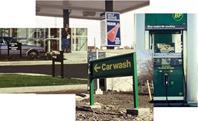
(Ord. 3195 § 3 (Exh. A), 2021).
22C.160.200 Window signs.
Window signs are signs which are applied directly to a window, or mounted or suspended directly behind a window. Window sign standards:
(1) Where permitted: first floor windows of commercial uses with a dedicated ground floor entrance.
(2) Maximum sign area: no more than 25 percent of storefront window.
(3) Maximum letter height: The letter height of each window sign shall not exceed 12 inches.
(4) Illumination: exposed neon tube illumination only.
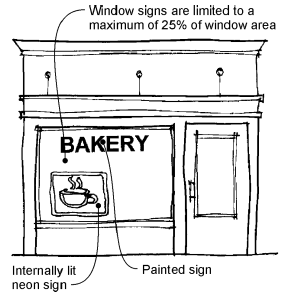
(Ord. 3195 § 3 (Exh. A), 2021).
22C.160.210 Projecting signs.
Projecting signs are permitted, in addition to the allowances for wall signs, when they comply with the following conditions:
(1) Where permitted: commercial uses adjacent to and facing a street.
(2) Orientation: Projecting signs may be either vertically or horizontally oriented.
(3) Projection.
(a) Horizontally oriented signs: not more than eight feet.
(b) Vertically oriented or square signs: not more than three feet.
(c) Signs may project over the sidewalk abutting the buildings, but must not extend over the curb into a parking or travel lane, or conflict with required turning radii.
(4) Height.
(a) Horizontally oriented signs: not more than three feet.
(b) Vertically oriented signs: must not extend above the building parapet, soffit, the eave line or the roof of the building
(5) Minimum vertical clearance over sidewalk: eight feet.
Dimensional standards for horizontal (left) and vertically oriented (right) projecting signs.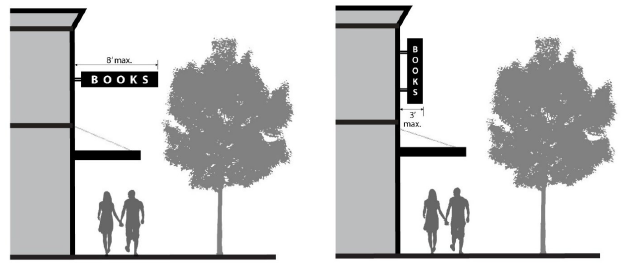
(Ord. 3195 § 3 (Exh. A), 2021).
22C.160.220 Marquee/awning signs.
Marquee/awning signs are a type of building-mounted sign that is either attached to, affixed to, or painted on a marquee, awning, or canopy. Marquee/awning signs are subject to the following standards:
(1) Sign Form and Size.
(a) Signs consisting of individual letters placed on the outside edge of the marquee or above the marquee are limited to 200 percent of the height of the vertical dimension of the marquee. For example, if the vertical dimension of the marquee is 12 inches, the letters may be up to 24 inches high. Such signs are limited to two-thirds of the individual marquee width dimension, or no more than 20 feet, whichever is less.
(b) Sign boards may be placed on the vertical edge of a canopy provided the height of the sign board is no more than 200 percent of the height of the vertical dimension of the marquee. For example, if the vertical dimension of the marquee is 12 inches, the sign board may be up to 24 inches high. Such signs are limited to two-thirds of individual marquee width dimension or no more than 20 feet, whichever is less.
(c) Signs placed on the vertical edge of awnings are limited to 80 percent of the height of the vertical edge of the awning. Where signs are placed on the sloping portion of the awning, they must be sized proportionally to the architectural features of the building and are limited to two feet in height. The width of awning signs is limited to two-thirds of the individual awning width dimension, or no more than 20 feet, whichever is less.
Marquee and awning sign examples & standards. 
(Ord. 3195 § 3 (Exh. A), 2021).
22C.160.230 Under-canopy signs.
Under-canopy signs are a type of building-mounted sign attached to the underside of an awning, canopy, balcony or arcade, and placed perpendicular to the storefronts and thus oriented to pedestrians on the sidewalk or an internal pathway. Under-canopy sign standards:
(1) Projection. Under-canopy signs shall have a one-foot minimum setback between both the sign and the outer edge of the awning, canopy, balcony or arcade, and between the sign and the building facade.
(2) Minimum vertical clearance over sidewalk: eight feet.
(3) Dimensions: shall not exceed two feet in height.
Under-canopy standards and example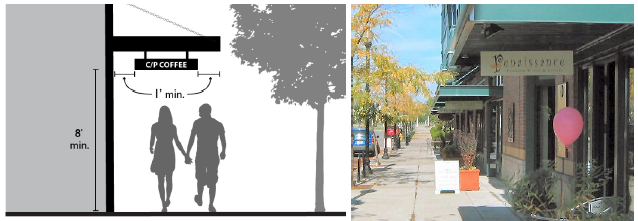
(Ord. 3195 § 3 (Exh. A), 2021).
22C.160.240 Building identification wall sign.
Building identification wall signs are signs located on and parallel to a building wall that announce the name of a building. Building identification wall sign standards:
(1) When permitted: commercial or multifamily residential uses with a dedicated ground floor entrance.
(2) Where permitted: only located on the frieze, cornice, or fascia area of storefront level; frieze, cornice, fascia, parapet of the uppermost floor; or above the entrance to the main building lobby.
(3) Number permitted: Only one building identification wall sign shall be permitted per building per street-facing facade.
(4) Sign area exemption: The area of building identification wall signs shall not count towards the total wall sign area allotment outlined in MMC 22C.160.160.
(5) Maximum sign height: no taller than 24 inches in height.
(6) Maximum projection: no more than one foot from the facade of the building.
(7) Illumination: external illumination or halo illumination only. (Ord. 3195 § 3 (Exh. A), 2021).
22C.160.250 Gas stations, convenience stores, car washes and similar uses.
(1) Signage shall be an integral design element of a project and compatible with the exterior architecture with regard to location, scale, color and lettering.
(2) Sign colors and materials shall match those of the building or the “corporate colors.” Opaque or muted sign backgrounds are encouraged.
(3) No commercial signage shall occupy the pump island area. All instructional signs shall be architecturally integrated.
(4) Gasoline price signs shall be architecturally integrated with other signs or structures. (Ord. 3195 § 3 (Exh. A), 2021).
22C.160.260 Temporary signs.
(1) No review is required for temporary signs, except for temporary signs requiring a temporary sign permit. All temporary signs shall conform to the following requirements:
(a) No temporary sign may be placed in a required parking space, driveway, or sight-distance triangle, pursuant to MMC 22C.010.240 and 22C.020.210.
(b) No temporary sign may be placed on city-owned property unless in conjunction with an approved special event permit, temporary sign permit, or other permission from the city.
(c) No temporary sign may be located upon or projecting over public streets, sidewalks, pedestrian paths, or bike paths except those of an official nature that are placed by a government agency for public safety purposes.
(d) No temporary sign may be placed in a traffic circle, roundabout, or median or in any storm water facility.
(e) Temporary general advertising signs are permitted only on the premises where the business, commodity, or activity being advertised is sold, offered, or conducted.
(f) Temporary signs in the city right-of-way placed outside the roadway shall comply with the following requirements:
(i) Location. Allowed only between the property line and the back of the nearest curb, or where no curb exists, between the property line and the nearest edge of the pavement. Signs may not be placed on sidewalks, driveways, or other paved areas designed for pedestrians or vehicular use.
(ii) Permission of the abutting landowner is required. The person, organization, or business placing the sign shall provide proof of the abutting landowner’s permission. If the person, organization, or business does not provide such proof in a form acceptable to the city, the sign may be removed from the right-of-way by the adjacent property owner or by the city.
(iii) Signs on stakes that can be manually pushed or hammered into the ground are allowed. All other signs are prohibited, unless specifically allowed by a right-of-way use permit.
(iv) Signs are limited to eight square feet total and six feet in height, from the ground to the top of the sign.
(v) Any temporary sign in the right-of-way that is dilapidated or a nuisance shall be removed by the person responsible for placement of the sign.
(vi) The city may allow other signs in a city right-of-way with approval of a right-of-way use permit.
(g) Residential Zones. Temporary signs may be placed on residentially zoned properties in accordance with the requirements of this section and the following:
(i) One temporary window sign per residential unit not to exceed eight square feet is allowed.
(ii) Freestanding signs, including post-mounted, stake, and portable signs are limited to eight square feet in size and six feet in height if the temporary sign is mounted in the ground, and not to exceed three feet in height if the sign is stake-mounted or portable.
(h) Nonresidential Zones. Temporary signs are allowed in nonresidential zones in accordance with the requirements of this section and the following:
(i) Window signs are limited to 25 percent of the window area.
(ii) Freestanding signs, including post-mounted, stake and portable signs are limited to eight square feet and six feet in height if the temporary sign is mounted in the ground, and not to exceed three feet in height if the temporary sign is stake-mounted or portable.
(iii) Surface-mounted signs are limited to 32 square feet and must be flatly affixed to walls or to on-site fences either facing the abutting street, or facing inward to the subject site.
(i) Temporary signs on large properties, either residential or nonresidential zones, of more than two acres may be of any type, and shall not exceed 32 square feet and up to eight feet above ground level. Such a sign allowed herein is in lieu of and shall not be displayed with or be in addition to any other temporary signs allowed by this section.
(j) The size of a temporary sign located in residential and nonresidential zones may be increased, subject to the director approving a temporary sign permit. In no case shall a temporary sign exceed 32 square feet.
(k) A temporary sign shall be promptly removed after the event for which it is intended by the person or organization that placed it. Ten days after the conclusion of the event the temporary sign relates to, the city may remove the sign from the right-of-way.
(l) Displays of banners, festoons, flags, posters, pennants, ribbons, streamers, strings of lights, balloons, and similar devices on a temporary sign are permitted for up to 30 consecutive days during a calendar year.
(2) Violations.
(a) Placing a temporary sign on private or public property without the permission of the landowner or placing a sign in the right-of-way without the permission of the abutting landowner is a violation under Chapter 4.02 MMC. When a sign identifies a person, organization, or business, there is a rebuttable prima facie presumption that the person, organization, or business placed the sign and committed the civil infraction.
(b) If the square footage of temporary signs placed on a parcel exceeds the limits permitted by this section, the owner of record will reduce the square footage to within the limits allowed by this section within three business days of being notified by the city. Notice mailed by the city is deemed effective three business days after being placed in the mail with sufficient postage. Failure to conform to the square footage limits within these timeframes is a violation under Chapter 4.02 MMC. Alternatively, a property owner may apply for a permit as a permanent sign.
(c) Any temporary sign that obstructs or impairs sight distance or access to a public sidewalk, public or private street or driveway, traffic control sign, bus stop, fire hydrant, structure, parked cars, bench or any type of street furniture, or otherwise creates a hazard is prohibited and may be removed by the city. Any temporary sign that mimics or is attached to a traffic control sign may be removed by the city. Any person who replaces a sign after notice that it was removed for any of these reasons or who refuses to remove a sign after notice that it violates this section commits a violation under Chapter 4.02 MMC.
(3) The city may remove any temporary sign within the right-of-way that violates any provision of this section. (Ord. 3296 § 7 (Exh. G), 2023; Ord. 3195 § 3 (Exh. A), 2021).
22C.160.270 Nonconforming signs.
(1) All existing signs in the city that were legally permitted and are not in compliance with the requirements of this chapter upon the effective date of the ordinance codified in this chapter are considered nonconforming signs. Nonconforming signs shall be made to conform with the requirements of this chapter under the following circumstances:
(a) When any new sign for which a sign permit is required by this chapter is proposed to be installed on a business site where a nonconforming sign or signs are located, one nonconforming sign of similar type as the proposed sign shall be removed or brought into conformance with this chapter for each new sign installed on a business site. For example, one existing nonconforming freestanding sign would need to be removed or brought into conformance for each new freestanding sign installed on a business site. A business site shall be considered both single-tenant and multi-tenant complexes. In no case shall an applicant be permitted signage that exceeds the maximum signage allowed in this chapter.
(b) A sign is relocated, altered, replaced, or changed in any way, including the sign structure or conversion of fixed copy to an electronic message center. This provision does not include a change in the face of the sign or advertising copy, or the conversion of the manual display of gas prices to an electronic, static display of gas prices.
(c) A sign requires repairs beyond normal maintenance.
(d) Whenever the occupancy classification of a building is changed that results in an intensification of land use, as determined by the community development director.
(2) Normal maintenance such as cleaning, painting, light bulb replacement, or repair of broken placards, without any change in copy, is allowed so long as the repairs do not modify the sign structure or copy, or in any way structurally alter the sign. “Normal maintenance” does not include any of the items contained in subsection (1) of this section.
(3) All temporary and special events signs that do not conform to the requirements of MMC 22C.160.260 shall be removed within six months of the effective date of the ordinance codified in this chapter or, if located within an area being annexed to the city, within six months of the effective date of annexation, whichever is later. (Ord. 3195 § 3 (Exh. A), 2021).
22C.160.280 Amortization for billboard signs.
(1) Compliance. Any legal nonconforming billboard sign located within the corporate limits of the city shall be discontinued and removed from the property pursuant to this section no later than three years from the date of adoption by ordinance.
(2) Notice. The city will provide written notice of the expiration of the amortization period, as noted in subsection (1) of this section, to the person, resident, or business responsible for such sign(s) at the last known address and to the owner of the property on which the sign is located. The city will utilize the tax assessor’s office to find the latest updated address for the property owner(s) in question. Such notice will be provided by mail, postmarked no later than nine months prior to expiration of the amortization period.
(3) Request for Consideration/Extension. The city has established the time period stated in subsection (1) of this section with the understanding that these time periods provide a reasonable time to recover the life expectancy of most signs. However, the city recognizes that there can be special or unusual circumstances that may fall outside of those parameters.
(a) Any person aggrieved by the imposition of the amortization clause may request review of the clause. The request for review shall be filed with the city not later than six months prior to the expiration of the amortization period. The review shall be heard by the hearing examiner. A fee will be charged based on the processing costs as provided in Chapter 22G.030 MMC.
(b) The aggrieved applicant has the burden of establishing the unreasonableness of the amortization period and must provide substantial evidence showing that the amortization period is unreasonable.
(c) The hearing examiner shall consider such things as lease obligations, remaining period of life expectancy of the nonconformance, depreciation, and the actual amount invested in the nonconforming sign.
(d) The hearing examiner shall consider the preservation and improvement of the city’s physical environment, natural amenities, and desirable characteristics of the city as asserted in the purpose of the city’s land use regulations as well as the goals and policies adopted in the city’s comprehensive plan. The hearing examiner may consider any combination of these legitimate public concerns.
(e) The hearing examiner shall conduct a balancing of interest, considering the interest and hardship as to the applicant, and whether the hardship to the applicant reasonably overbalances the benefit that the public would derive from the termination of the nonconformance. If, after careful consideration, the hearing examiner determines that the amortization period, as applied to the applicant’s nonconformance, would result in a greater hardship to the applicant than benefit to the public, the hearing examiner may extend the amortization period to a point in time when the balancing of interest would support the termination of the nonconformance. In no event should this amortization period be greater than three additional years.
(4) Annexations. Any legal nonconforming billboard on property annexed into the city at a later date shall be discontinued and removed within three years of the annexation or according to the annexation agreement established at the time of annexation. A three-year time extension may be approved by the hearing examiner, subject to the provisions contained in subsection (3) of this section. (Ord. 3195 § 3 (Exh. A), 2021).
22C.160.290 Bonus allowance for outstanding design.
(1) Purpose. A maximum 50 percent sign area bonus and a maximum 25 percent height bonus shall be allowed under any of the following circumstances:
(a) There are exceptional circumstances or conditions, such as location of existing structures, lot configuration, topographic or unique physical features, that apply to the subject property which prohibit sign visibility.
(b) New developments greater than 10 acres in size that wish to consolidate the allowable signage. A minimum of two signs will be required to be consolidated for a bonus consideration.
(c) Contiguous or multi-tenant properties sharing the same street frontage that wish to consolidate allowable signage. A minimum of two signs will be required to be consolidated for a bonus consideration.
(2) Procedures. A request for a bonus allowance may be granted by the community development director subject to the approval criteria outlined in subsection (3) of this section. Appeal or request for reconsideration of the director’s decision shall be made to the hearing examiner as an open record hearing in accordance with Chapter 22G.010 MMC, Article VIII, Appeals.
(3) Approval Criteria. A bonus will be approved if the community development director finds that the criteria below are met:
(a) The adjustment will not significantly increase or lead to street-level sign clutter, to signs adversely dominating the visual image of the area, or to a sign that will be inconsistent with the objectives of a subarea master plan or special overlay district.
(b) The adjustment will not create a traffic or safety hazard.
(c) The adjustment will allow a unique sign of exceptional design or style that will:
(i) Achieve a positive and tasteful image;
(ii) Have good legibility;
(iii) Exhibit technical competence and quality in design, construction, and durability, and have standard details uncluttered by wires, angles, or other elements that detract from the appearance;
(iv) Relate to architectural features rather than obscure or disregard building planes;
(v) Present a harmonious relationship to other graphics and street furniture in the vicinity;
(vi) Be of a size that is in scale with the setting, building, or structure where located; and
(vii) Avoid glare.
(4) Application Requirements. An applicant requesting a bonus allowance under the provisions of this chapter shall submit the following:
(a) A letter in memorandum form outlining how the request is consistent with the criteria of this subsection.
(b) A site plan that is accurately drawn to an engineered scale that includes the following information:
(i) Boundaries and dimensions of the site;
(ii) Location of buildings, parking areas and adjacent streets;
(iii) Graphic representations of all existing signs including their size, height and placement on the site;
(iv) Graphic representation of the proposed sign(s) subject to the request; and
(v) Building elevation showing the placement of the sign on that elevation, if applicable.
(5) Timing. The community development director or designee shall render a written decision on the requested bonus for outstanding design within 10 business days of submittal of all required elements and filing fee.
(6) Variance Required. Requests that exceed the 50 percent sign area bonus and 25 percent height bonus, those that do not comply with the purpose outlined in subsection (1) of this section, or those not related to allowable sign height or sign area shall be processed as a variance in accordance with MMC 22C.160.300. (Ord. 3195 § 3 (Exh. A), 2021).
22C.160.300 Variances.
Any person may apply for a variance from the requirements of this chapter. Sign variances shall be processed by the hearing examiner pursuant to the procedure set forth in Chapter 22G.060 MMC. Variance applications shall be processed pursuant to the review procedures outlined in Chapter 22G.010 MMC. A fee will be charged based on processing costs as provided for in Chapter 22G.030 MMC. In making any decision on a variance application, the permit authority must adopt findings of fact and conclusions based on those findings that address whether or not the application meets the following criteria for approval:
(1) The variance does not conflict with the purpose and intent of the sign regulations;
(2) The variance shall not constitute a grant of special privilege inconsistent with the limitation upon signage of other properties that have had to conform to the provisions of this chapter;
(3) There are exceptional or extraordinary circumstances or conditions applicable to the property involved, or to the intended use of the property, that are not contemplated or provided for by this chapter;
(4) The granting of such variance will not be materially detrimental to the public welfare or injurious to the property or improvements in the vicinity and zone in which the subject property is situated; and
(5) The granting of such variance would not increase the number of signs allowed by this chapter or that would allow a type of sign that is prohibited by this chapter.
Conditions may be imposed upon the application as deemed necessary to ensure compatibility with this chapter. (Ord. 3195 § 3 (Exh. A), 2021).
22C.160.310 Substitution.
Notwithstanding anything in this chapter to the contrary, noncommercial copy expressing a personal, political, or religious point of view may be substituted for commercial copy on any lawful sign structure. (Ord. 3195 § 3 (Exh. A), 2021).


